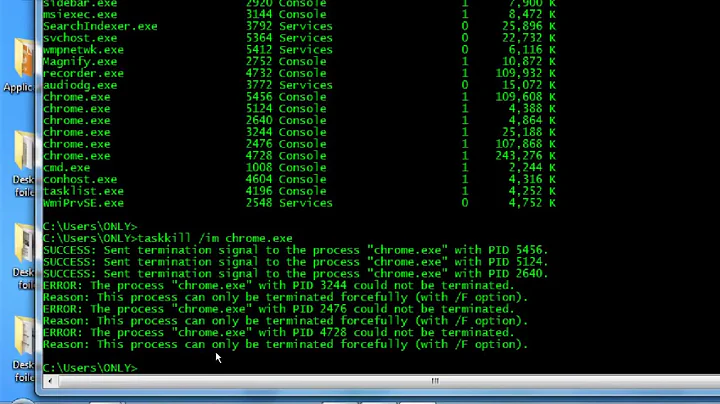How does Windows kill a process, exactly?
20,166
"End Task" (and taskkill) appears to post a WM_CLOSE message to the program's windows. (The same is done when you click the × "Close" button.) If the program does not exit in some time, user gets prompted to end the program forcefully.
"Kill Process" and taskkill /f use TerminateProcess().
Related videos on Youtube
Author by
user3531602
Updated on September 17, 2022Comments
-
user3531602 almost 2 years
I'm unfamiliar with how processes are killed in Windows. In Linux, a "warm" kill sends a signal (15) which the process can handle by instantiating a signal handler. A cold kill is signal (9) which the OS handles by killing the process forcefully.
How can I "kill" a process in Windows? How is it handled by OS and by the process? What actions does OS perform? Is there a cross-platform way of responding to a kill/close request?
-
user1686 about 14 yearsFor readers: Signal 15 is
SIGTERM, 9 isSIGKILL. -
 Oliver over 10 yearsPlease accept an answer, if your question has been answered.
Oliver over 10 yearsPlease accept an answer, if your question has been answered.
-
-
 Philip about 14 years+1, WM_CLOSE sent to app; after X time ask user to force kill, Windows removes the process from the scheduler, closes all handles (which can trip up the process if the kernel is processing one of those handles), then reclaims the memory space (this is the really short version of the process).
Philip about 14 years+1, WM_CLOSE sent to app; after X time ask user to force kill, Windows removes the process from the scheduler, closes all handles (which can trip up the process if the kernel is processing one of those handles), then reclaims the memory space (this is the really short version of the process). -
user1686 about 14 yearsThe third way is
ntsd -p <pid> -c q, which uses thentsddebugger; I'm not sure what happens when a program is killed that way. (pokes @Chris) -
user3531602 about 14 yearswhat happens if the program doesn't have a window?
-
user1686 about 14 years@IttayD: Then there's no entry in Task Manager to use "End Task" on :) I just tried
taskkilland it replies with: "This process can only be terminated forcefully ( with /F option )." So yeah, the only choice left isTerminateProcess(). -
user1686 about 14 years@IttayD: Note that on Windows, services (daemons) are written differently from user applications; they can receive status queries and control requests from Service Manager, so a graceful stop is possible.




